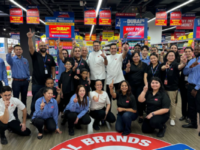When CEO Karim Messih began his stint at Zambrero nearly four years ago there were just 33 restaurants, now the numbers stack up to 150. So how has this expansion been rolled out?
While it was always the company’s longterm plan to achieve economies of scale Messih stresses that growth is not for its own sake.
Zambrero has grown its franchised chain by 30 to 40 stores annually for the past three years and Messih sees this continuing for at least the next two years.
What you need to know about its network growth…
1. Franchising works
The chain is 100 per cent franchised. While Messih sees advantages in either corporate or franchised outlets he is no fan of merging the two.
“Doing both is hard, where does your focus lie? If sometimes there is friction between corporate stores and franchises, who do you support?” he asks.
2. Agents on the ground
The business is run on a development agent basis, with each agent taking on a regional territory or State in which they deploy the necessary resources to meet the scheduled goals and operate a restaurant themselves.
3. Multi-units
Much of the expansion comes from within the existing network; Messih regards this as a positive, because current franchisees already have knowledge of brand and systems. And the economies of scale works well for franchisees too, if they are operating two to four restaurants.
“It has its own challenges,” he says, “but we’re finding it has more uptake.”
4. The right people
“Surrounding yourself with the right people is critical as a franchisor but also for franchisees. We want people who want to be a part of the movement we’re creating.”
And that’s why it’s easy for franchisees to open a second and third outlet, he says.
“We’ve been pretty tough from day one. Because of our humanitarian DNA, we want people to believe in what we believe. It’s crucial to get the people right, and you don’t always, but you want to have more wins.”
5. Location, location
Regional areas have been a focus, with stringent planning to ensure the right demographics, to position outlets where the brand will work well.
“Location is so key. You can be in the best street in a suburb but in the worst spot and it’s not good. Out of the sweet spot is really a struggle," he believes.
6. Business models
The Mexican chain operates food court, strip location, kiosk and 16 drive-through models and takes a balanced approach to the spread of outlets around the country; the different models will suit diverse locations, says Messih.
What’s important is to capitalise on the option to cater for both lunchtime and dinner trade.
7. Customer focus
At the heart of Zambrero’s growth is a customer-centric focus.
“It starts with your products. We consider ourselves product people, we have an obsession about what we sell, and the quality of ingredients," says Messih.
8. Staying relevant
It’s all about providing the right marketing systems, working in the digital space, accessing the technology to capture every customer to market to them. As Messih says, "to keep them sticky to the brand".
Messih highlights the importance of remaining relevant to the customer – right now that’s reflected in loyalty programs, online ordering and home delivery.
The home delivery service was launched about six months ago through Deliveroo and Uber Eats and has brought “good successes” he says. “For some of our metro markets home delivery is adding real value to the business.”












